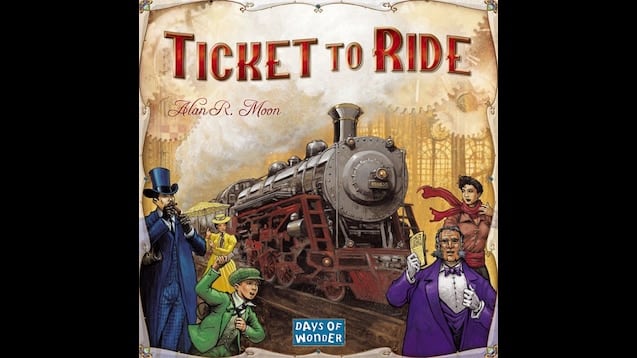Let’s wind back the clock to 2004, when game designer Alan R. Moon had one simple goal: make a train game that didn’t take all night to play. The result? Ticket to Ride, a sleek, easy-to-learn board game that blends accessibility with just enough strategy to make everyone feel smart. Published by Days of Wonder, the game quickly won over fans and critics. It even snagged the 2004 Spiel des Jahres (basically the Oscars of board games). Not bad for a game about trains.
What made A Ticket to Ride stand out was how elegantly it combined tension and relaxation. Unlike more complex strategy games that can scare away newcomers, Ticket to Ride invited everyone to the table, grandparents, casual players, and hardcore strategists alike. It struck that rare balance of being light on rules but rich in gameplay, and that’s a formula the industry had been craving.
How to Play Without Derailing Your Brain
The rules? Easy. You’re collecting colorful train cards, claiming routes between cities, and completing secret destination tickets to score points. But don’t let the simplicity fool you; this game has bite.
You’ll score by:
- Completing destination tickets
- Claiming longer continuous routes
- Finishing with leftover train pieces (yes, leftovers matter here)
The trick is managing your hand while watching out for other players because nothing stings quite like someone claiming your route to Atlanta. Strategic blocking becomes part of the fun (and the grudges).
Variants, Spin-offs, and Global Tracks
After the base game exploded in popularity, Days of Wonder got to work expanding the universe, and they didn’t stop. Here’s just a taste:
- Europe : Ferries, tunnels, and train stations? Oui, s’il vous plaît.
- Germany: More passengers, more strategy.
- Nordic Countries: A cozy, snowy twist.
- Rails & Sails: Sea routes for the globetrotters.
- Map Collection series: Double-sided boards with wild new mechanics.
- First Journey: A kid-friendly version with the same fun vibe.
Each one brings its own flavor to the table, whether you’re into tactical expansions or just want new scenery. The expansions keep the gameplay fresh, and for many, collecting these maps becomes part of the hobby itself.
From Board to Classic
So how did this charming little train game become a modern board game titan? Easy:
- It’s approachable. You can teach it in under 10 minutes.
- It looks great. Clean design, nice pieces, and a satisfying layout.
- It scales. Works great for families, classrooms, casuals, and strategy lovers alike.
Ticket to Ride is also a superstar in over 30 languages and has sold more than 10 million copies. It’s the definition of a crossover hit.
It also made a huge splash in education spaces. Teachers and libraries often include it in their collections due to its light geography lessons and soft introduction to planning and resource management. It’s proof that learning and fun can ride the same track.
Going Digital? All Aboard!
The train doesn’t stop at cardboard. Ticket to Ride is fully playable online and on multiple platforms:
- Steam
- iOS
- Android
- PlayStation
- Xbox
Features include:
- Online multiplayer (yes, you can finally beat your cousin in another state)
- AI opponents
- Expansions available for download
- Streamlined tutorials
The digital versions have made it even easier for new players to hop on board, literally. With seasonal challenges and multiplayer leagues, the digital scene has created an entire community of fans.
Fun Facts & Ticket Trivia
If you thought Ticket to Ride was just about trains and colored cards, think again.
- In 2011, Days of Wonder hosted a map design contest, and the winners, India and Legendary Asia, became official expansions. That’s fan power in motion!
- There’s a Legacy version called Legends of the West, where each game in the 12-part campaign permanently changes your board. By the end, you’ll have a personalized version of the game that tells your story.
- he game’s creator, Alan R. Moon, originally called the prototype Thunder on the Tracks, which later became Station to Station before ultimately being renamed Ticket to Ride. Let’s just say the final name was a first-class decision.
Community Buzz & Competitive Tracks
This game isn’t just something you play at home. It’s got a scene.
- Online tournaments and global championships pop up regularly for those who want more than just friendly competition.
- There are even Discord servers, community leagues, and Twitch streams dedicated to strategizing the best rail routes. (Yes, train content can go viral. It’s 2025; roll with it.)
- Teachers use it in classrooms to teach geography. Libraries stock it for community game nights. It’s a certified crowd-pleaser.
The Legacy of a Board Game Legend
Ticket to Ride didn’t just sell millions, it changed how people approach board games. It’s often mentioned in the same breath as Catan and Carcassonne when talking about “gateway games”, the ones that pull people into the hobby.
- Its smooth blend of strategy and accessibility influenced a wave of similar light strategy games.
- Designers still point to its elegant mechanics as inspiration when building their own projects.
Basically, Ticket to Ride was, and still is, a blueprint for how to make a board game that lasts.
Final Stop: Why This Game Still Rules
In a sea of overly complex or overly gimmicky games, Ticket to Ride keeps it classy. It proves you don’t need a zillion tokens or 400-page rulebooks to create tension, competition, and fun.
Whether you’re:
- Wrangling the family for game night
- Starting your board game journey
- Looking for something to play without flipping tables
Ticket to Ride delivers. It’s cozy. It’s clever. And it just keeps rolling along. If you haven’t played it yet, there’s a seat waiting for you. All aboard!


